Think of this: your support team flagged a billing complaint trend last Tuesday. By Friday, two major enterprise accounts churned for the same reason.
You saw the pattern and set things in motion to act, but it’s already too late.
This scenario plays out daily for CX leaders at subscription businesses. You're drowning in feedback from support tickets, app reviews, social media, and chat logs, but the signals that predict churn stay buried until customers are already gone.
The truth is, traditional surveys tell you what happened last quarter. But your modern retention strategy needs to know what's breaking right now.
Voice of Customer frameworks solve this exact problem. They transform scattered feedback into a systematic process that detects churn risks in real time.
So, instead of reacting to problems after only revenue walks out the door, you can identify the exact drivers of dissatisfaction and act before customers leave.
This guide explores how to build effective VoC frameworks that connect customer feedback directly to retention outcomes, with specific examples of how SentiSum's AI-native VoC platform turns feedback into actionable churn prevention strategies.
What Is a Voice of Customer Framework?
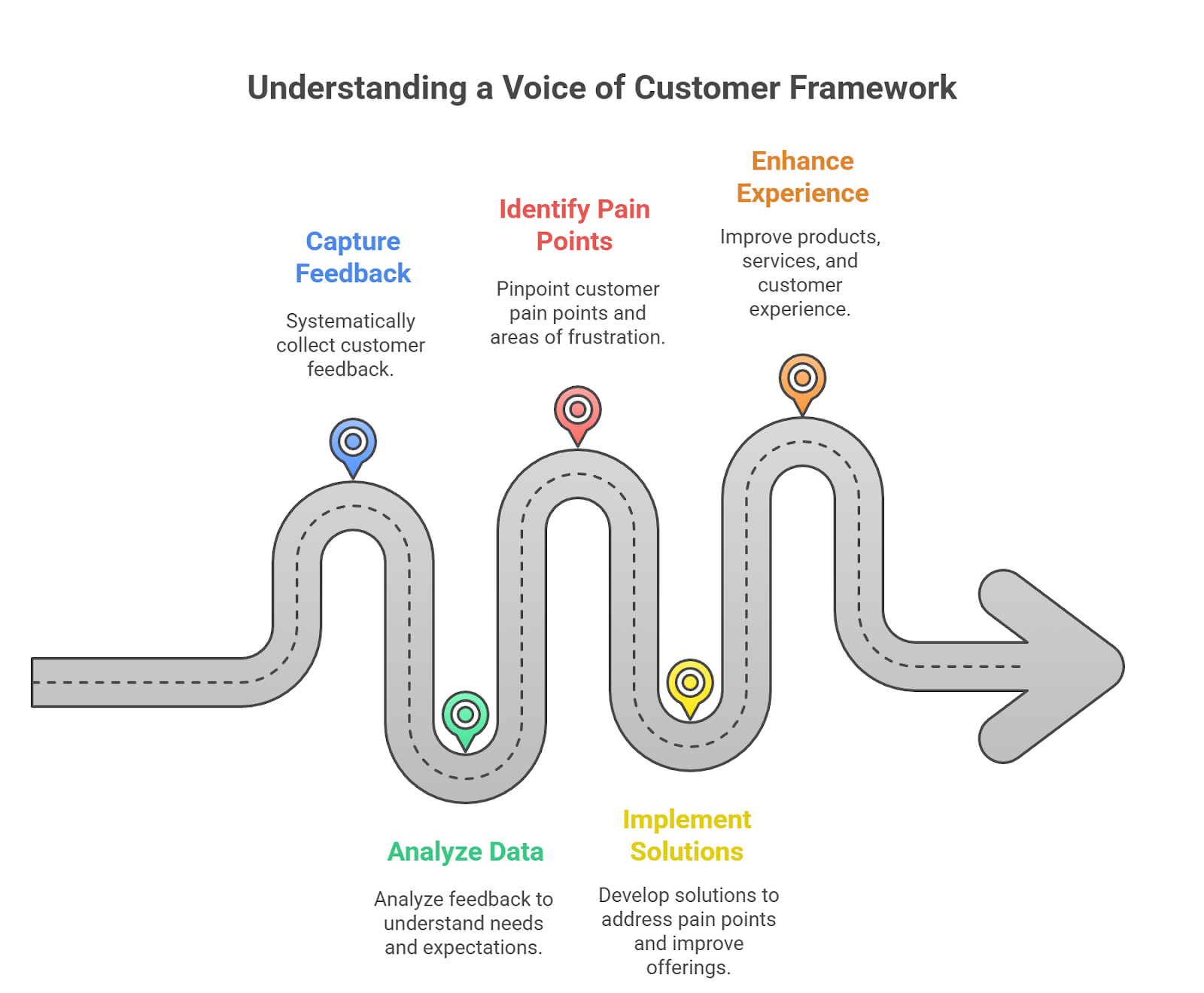
A Voice of Customer framework is a systematic process for capturing, analyzing, and acting on customer feedback. It moves beyond collecting scattered data points to create a centralized, actionable understanding of customer needs, expectations, and pain points.
For instance, think of a telecom company that notices a high volume of support calls. Rather than guessing the cause, their Voice of Customer frameworks analyze thousands of call transcripts.
Through the analysis, it identifies ‘unclear billing’ as the specific reason for customer frustration. The company then simplifies its bill format and creates targeted educational content, directly reducing support contacts and improving customer trust.
The VoC framework basically ensures insights directly inform improvements in products, services, and the overall customer experience. By consistently listening and responding, businesses can make truly customer-centric decisions that actually enhance satisfaction and loyalty.
Building Effective Voice of Customer Frameworks
Each industry has unique customer journeys and pain points. Naturally, their VoC feedback frameworks are going to differ.
To help you understand how Customer feedback analysis frameworks are built in real life and how they work, we have taken three major industries:
VoC Framework in Retail
In retail, social media sentiment can dictate brand perception overnight. A common challenge is a viral post about a product quality issue that support tickets haven't yet captured.
- Framework focus: Real-time social media listening integrated with support ticket analysis
- Example situation: A fashion retailer notices a social media trend where customers complain that a 'new fabric is itchy.' This hasn't appeared in surveys yet.
However, their VoC feedback framework, using AI-powered text analysis, automatically groups these social comments with a few support tickets mentioning 'skin irritation,' confirming a product flaw. - Action: The product team is alerted immediately. They use this direct customer voice to work with suppliers on a material change and proactively address the issue online.
VoC Framework in SaaS
For SaaS companies, understanding why customers use a feature is more important than knowing if they like it. The Jobs-to-Be-Done (JTBD) theory, for example, can set context here:
- Framework focus: Analyzing feedback to uncover the 'job' a customer hires your product to do.
- Example situation: A project management tool finds users are frustrated with its reporting feature. A traditional approach might try to improve the existing feature. But their JTBD-informed VoC framework reveals that customers use ‘reports’ to secure the budget from management.
- Action: The team redesigns the reporting feature to include pre-built templates for business cases and ROI calculations, directly fulfilling the core customer need and increasing subscription renewals.
VoC Framework in Healthcare
Healthcare providers must balance patient satisfaction with operational efficiency. The Kano Model, for instance, helps categorize feedback into features that cause delight, satisfy basic expectations, or cause dissatisfaction.
- Framework focus: Categorizing patient feedback to prioritize facility improvements.
- Example situation: A clinic analyzes patient survey data and online reviews. They discover that 'short wait times' (a basic expectation) is a major dissatisfaction driver when it's not met.
Meanwhile, 'digital intake forms' (a performance need) improve satisfaction, and 'follow-up wellness tips via SMS' (a delighter) generate positive word-of-mouth. - Action: The clinic prioritizes reducing wait times as a critical fix, continues to optimize digital forms, and plans to roll out the SMS program to enhance patient loyalty systematically.
Now that you have understood the crux of the customer feedback analysis framework, let’s look at the key elements a good VoC framework must have.
Key Elements of Voice of Customer Frameworks
A truly successful VoC framework is one that fully listens, understands, and acts.
Here are the seven key components (or say elements) you need to build effective Voice of Customer frameworks:
1. Define clear objectives and stakeholders
Before asking a single question, you must know why you are asking it. Voice of Customer frameworks without clear goals collect data that no one uses.
Start by asking: What specific business problem are we trying to solve? Is it reducing customer churn, improving a specific product feature, or increasing customer lifetime value?
Once the objective is set, identify the key stakeholders: CX leaders, data scientists, or teams in product, marketing, support, and executive leadership who own these outcomes. Their early involvement ensures the insights your VoC feedback framework gathers will be relevant and acted upon.
2. Collect data from diverse sources
A true customer perspective comes from a trio of sources: what customers say, what they do, and the problems they report.
- Surveys (what they say): This includes direct feedback like NPS, CSAT, and post-interaction surveys.
- Behavioral data (what they do): This is the indirect feedback found in website analytics, product usage patterns, and feature adoption rates. Are users consistently abandoning their cart at the same step? That is a powerful, unsolicited piece of feedback.
- Support interactions (problems they report): Analyze support tickets, live chat logs, and call center notes. This data reveals the most pressing friction points your customers face daily.
3. Map journeys and target critical touchpoints
Customer feedback should not be collected in a vacuum. Map it to the specific stages of the customer journey. Where are the key moments of truth?
Where are the key moments of truth? For an e-commerce business, a critical touchpoint is the 'post-purchase delivery experience.'
In healthcare, this could be a patient's first follow-up appointment after a new diagnosis. For a software company, it's the 'onboarding completion' milestone.
Targeting a survey at these precise moments, rather than at a random time, provides concrete, actionable feedback about a specific part of your service.
4. Centralize and integrate all data
To avoid departmental silos, you need a single source of truth. Ideally, your customer experience framework must capture all your feedback, from survey tools, CRM, support software, and analytics platforms, into a centralized dashboard.
This allows you to see the complete picture at a glance and also formulate immediate action.
For example, you can correlate a drop in a product's usage data (behavioral) with a recent spike in negative app store reviews (survey). This connection reveals the root cause, not just a symptom.
5. Analyze both qualitative and quantitative methods
Numbers tell you what is happening, but words tell you why.
One good voice of customer best practice is to combine quantitative data (scores, metrics, statistics) with qualitative analysis (thematic analysis of open-ended responses, sentiment analysis of support tickets).
If your NPS score drops (quantitative), the accompanying comments (qualitative) will explain the reason, such as ‘shipping is too slow.’ This mixed-method approach provides the context needed for decisive action.
6. Close the loop and govern change
This is where most VoC frameworks fail: the gap between insight and action. Establishing a closed-loop process is non-negotiable.
For a customer who gives a low score, this means a dedicated person must follow up to resolve their specific issue. On a larger scale, it means governing the changes your insights demand. Does the product roadmap reflect the top feature requests? Has the marketing team updated materials based on customer-confirmed pain points?
This ongoing, active governance turns feedback into a driver of tangible change.
7. Measure impact and iterate
Finally, a customer experience framework is not a ‘set it and forget it’ project. You must measure its true and on-ground impact on the business goals you defined at the start.
Track how changes inspired by VoC data affect key metrics like churn rate, customer lifetime value, or operational costs. Use these results to refine your approach. Ask what's working, what isn't, and adapt your questions, channels, and processes accordingly.
This cycle of continuous improvement ensures your VoC program remains relevant and powerful.
Why SentiSum Is One of the Best Voice of Customer Tools?
Most VoC feedback frameworks document customer opinions; they don't drive operational change. They tell you what happened, but fail to connect that information directly to the people who can fix it.
As an AI-native VoC platform, SentiSum re-engineers this process, acting as an active system for your customer experience and properly closing the loop between customer pain and internal action. Here’s how:
Real-time churn flagging powered by Kyo AI Agent
Most VoC platforms collect feedback. SentiSum's Kyo AI Agent actively hunts for what's breaking and why.
Kyo unifies all your customer feedback into one brain, continuously scanning support tickets, call transcripts, and reviews to detect churn risks before they cost you revenue.
Here's what makes Kyo different: it connects disparate signals across your feedback sources to identify patterns invisible to traditional analysis.
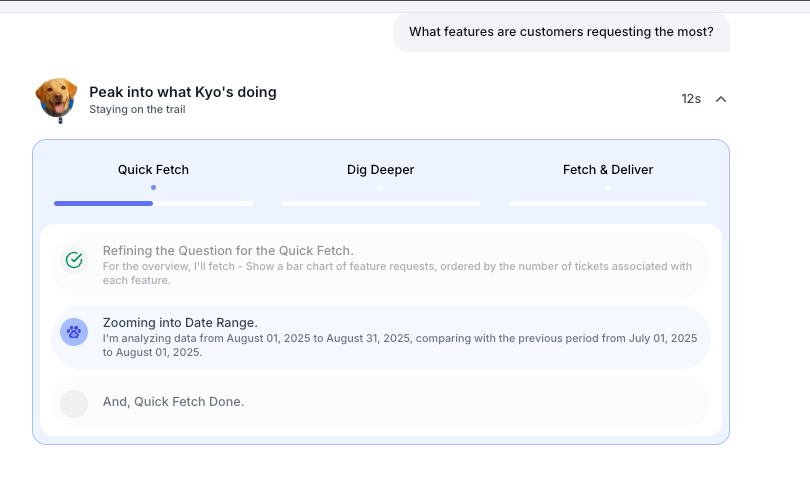
For example, when login issues spike 40% among enterprise accounts while CSAT drops 15 points for the same segment, Kyo doesn't just report two separate data points. It flags this correlation as a high-risk churn event and highlights the exact anomaly causing customer frustration.
As a result, your team gets specific, actionable intelligence: which customer segment is at risk, what's driving their dissatisfaction, and what action to take next.
This real-time detection means you can fix problems while customers are still engaged, not after they've already left.
Democratizing insights with role-specific intelligence
A product manager needs different data than a support team lead. SentiSum tailors its intelligence for each role, delivering personalized insights to each team.

The product team sees feedback on new features, while marketing understands churn reasons. This specialization turns the VoC platform from a generic tool into a personal assistant for every team, ensuring everyone sees what drives their specific outcomes.
Turning agent insights into frameworks for improving customer retention
Your support agents hold invaluable, untapped knowledge about why customers stay or leave. SentiSum analyzes agent notes and internal commentary alongside customer feedback.
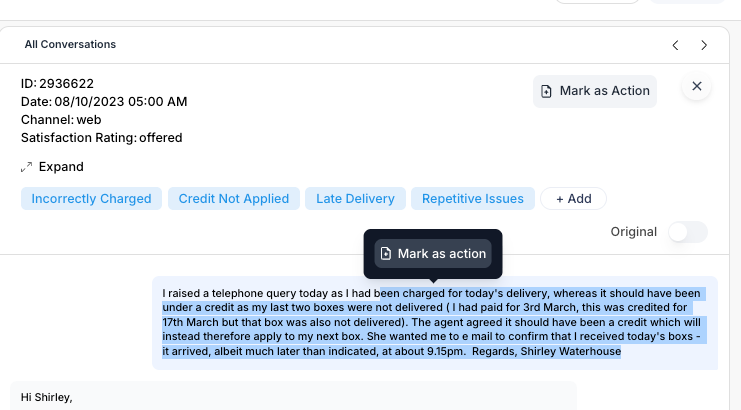
This reveals systemic issues agents repeatedly see but can't escalate effectively, such as a confusing returns process that drives post-purchase churn. By giving a voice to both the customer and the agent, SentiSum uncovers the procedural flaws that damage retention, allowing teams to fix operational root causes.
Proactive reputation management from unstructured feedback
Negative reviews and social media comments are often discovered too late, after they've influenced potential customers. SentiSum continuously monitors all public feedback channels like Trustpilot and app stores in real-time.

It doesn't just alert you to a negative review; it understands the context and severity, and can automatically generate a support ticket for your team to take immediate, direct action.
Closing the loop with customers on fixed issues
A key pillar of a strong VoC framework is proving to customers that their feedback matters. SentiSum’s ‘Action Tracker’ enables this directly.

When a widespread issue, like a mobile app bug, is identified and resolved, your team can filter for all customers who reported it. Your team can then trigger a personalized message informing them that the problem is fixed.
This direct ‘close-the-loop’ communication demonstrates you listen and act, increasing loyalty and reducing the chance that customers will churn over a previously resolved pain point.
Creating a self-learning VoC framework that adapts to new churn threats
Static VoC taxonomies cannot capture new or emerging churn reasons. But not SentiSum. It automatically detects new complaint topics or changes in customer language without requiring manual updates.
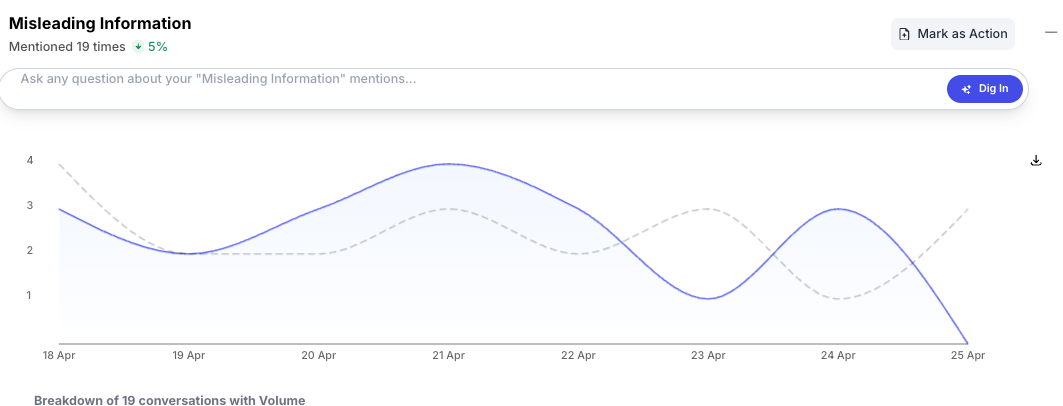
If customers, for instance, start mentioning a new competitor or a previously unknown product flaw, the system identifies this emerging trend and alerts you. This ensures your customer experience framework is always aligned with the current reasons customers are leaving, making your frameworks for improving customer retention proactive instead of reactive.
➡️ Read More
From Siloed Feedback to Instant Action: How JustPark Fixed Problems Before They Cost Thousands
📽️You can also watch the full video here:
SentiSum x JustPark | JustPark Turns Driver Feedback Into Instant CX Wins (Case Study)
Move beyond data collection to a proactive Voice of Customer strategy. To see how SentiSum uncovers the specific drivers of churn and loyalty, book a demo and elevate your customer retention today.
Heading 1
Heading 2
Heading 3
Heading 4
Heading 5
Heading 6
Lorem ipsum dolor sit amet, consectetur adipiscing elit, sed do eiusmod tempor incididunt ut labore et dolore magna aliqua. Ut enim ad minim veniam, quis nostrud exercitation ullamco laboris nisi ut aliquip ex ea commodo consequat. Duis aute irure dolor in reprehenderit in voluptate velit esse cillum dolore eu fugiat nulla pariatur.
Block quote
Ordered list
- Item 1
- Item 2
- Item 3
Unordered list
- Item A
- Item B
- Item C
Bold text
Emphasis
Superscript
Subscript

.webp)
.webp)





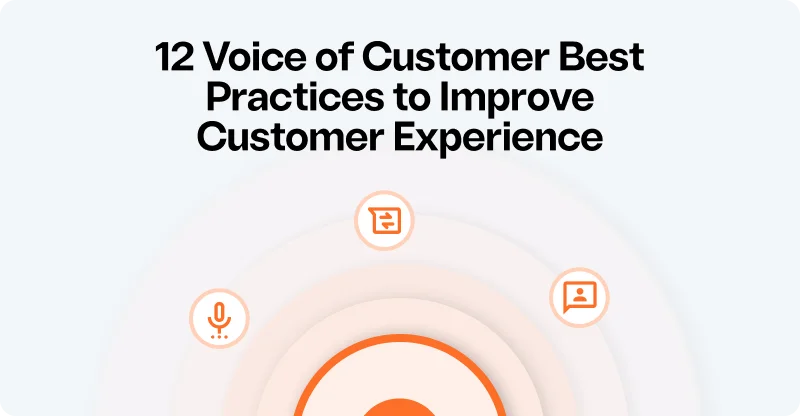

.png)
.webp)
.svg)
.svg)







